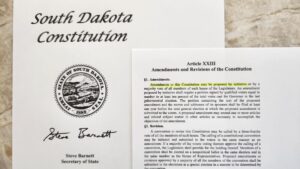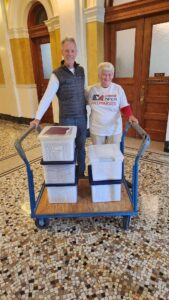As we approach the November election, voters will start to focus on the ballot issues they are being asked to decide. There are seven this year, which is about normal.
Two of the seven are constitutional amendments submitted to voters by the legislature. They must get our permission when they want to change the Constitution. The other issues are on the ballot because of citizen-led petition drives.

South Dakota Constitution
Direct democracy allows voters to decide a specific issue. We have over a century of direct democracy history in South Dakota; we like voting on ballot issues. But the political class in our state doesn’t like it.
Large Swaths of Voters Are Underrepresented
One of the reasons initiatives are so popular in South Dakota is that our legislature is often out of touch with voters. Many legislators are elected by and answerable only to the partisans in their party, which skews their perspectives. As a result, the legislature’s views often do not represent those of regular South Dakotans.
Our representative democracy governance system has been distorted under one-party rule and a closed primary election system. What may have once been workable under a two-party system no longer functions fairly. Today, large swaths of our electorate are underrepresented in the legislature.
The state’s closed primary election system gives party bosses the power to pick candidates and winners. A quarter of us, 150,000 independent voters, have no representatives. Another quarter has about 10% of the representatives. Meanwhile, half of us get 90% of the representatives and all of the statewide offices.
Political Elites Don’t Like to Let the People Decide
Every two years as an election involving ballot issues approaches, we inevitably hear political pundits utter two falsehoods. First, they suggest it is too easy to put an issue on the ballot in South Dakota. Second, they say voters have too many ballot issues to decide. The state’s political class tends to conveniently forget what a normal number of ballot issues is in our state. Of course, they would prefer that important decisions be left to the political establishment in Pierre. They don’t trust voters to understand all the nuances and do the right thing. Nevertheless, South Dakota voters continue to embrace direct democracy.
Huge Challenge to Put an Issue on the Ballot
I have been involved in a couple statewide petition drives and hope to not have to do another. The time and expense are overwhelming. Yet many in the political class have convinced themselves that it is too easy, and they annually propose creative attacks on the process to make it more difficult and expensive. Luckily, the courts and the voters keep pushing back.

Joe Kirby and De Knudson prepare to file the open primaries petitions
Voters Like Ballot Issues
South Dakota voters like voting on ballot questions. The number of people who vote on them sometimes exceeds the number who vote on filling statewide offices like governor or US senator. They like learning about the issues and making up their own minds, often in ways that differ from what the party boss-controlled legislature would do. That’s exactly why we embrace direct democracy in South Dakota. After all, our state slogan is “Under God, the People Rule!”
A Brief History of South Dakota Ballot Issues
At the end of the 19th century, South Dakota was the first state in the country to adopt direct democracy. In the 1890s, South Dakota voters saw 14 ballot issues. The following decade the number grew to 18. Then in the 1910s voters were asked to decide a record 54 ballot questions. But the number has stabilized since then.
Starting in the 1970s, we have averaged around 30 ballot issues every decade, which is six for each of the five election years. That’s just a bit below the number of ballot issues voters will decide this November.
| History of Ballot Issues in South Dakota | |||||
| Decade | # of Ballot Issues | ||||
| 1890s | 14 | ||||
| 1900s | 18 | ||||
| 1910s | 54 | ||||
| 1920s | 22 | ||||
| 1930s | 20 | ||||
| 1940s | 23 | ||||
| 1950s | 19 | ||||
| 1960s | 23 | ||||
| 1970s | 32 | ||||
| 1980s | 27 | ||||
| 1990s | 32 | ||||
| 2000s | 35 | ||||
| 2010s | 30 | ||||
This Year’s Ballot Issues
This year’s issues include crowd-attracting topics like abortion, underground pipelines and recreational marijuana. They also include important ones like open primaries and eliminating the sales tax on groceries. The other two, from the legislature, involve cleaning up gender language in the constitution and making Medicaid patients work. I trust that South Dakota voters will do their homework and make good choices on each. And I suspect the political class, as it has done in the past, may then try to undermine the people’s decisions on one or two of the issues.
Herre are the seven ballot issues voters will see on their ballots in November. Each title will have an attorney general explanation of approximately 200 words.
Amendment E – An amendment to the Constitution of the State of South Dakota, updating references to certain officeholders and persons.
Amendment F – An amendment to the Constitution of the State of South Dakota, authorizing the state to impose work requirements on certain individuals who are eligible for expanded Medicaid.
Amendment G – An initiated Amendment Establishing a Right to Abortion.
Amendment H – An amendment to the South Dakota Constitution Establishing Top-Two Primaries.
Initiated Measure 26 – An Initiated Measure Prohibiting Taxes on Anything Sold for Human Consumption.
Initiated Measure 27 – An Initiated Measure Legalizing the Recreational Use, Possession and Distribution of Marijuana.
A Referred Act to Provide New Statutory Requirements for Regulating Linear Transmission Facilities, to Allow Counties to Impose a Surcharge on Certain Pipeline Companies, and to Establish a Landowner Bill of Rights.
Direct Democracy Solves Problems
Imagine how much better our country might be today if we had direct democracy at the national level. Pesky issues like immigration, abortion, border security, gun control and term or age limits for public officials might have been reasonably decided long ago. And I suspect our election system would have been overhauled to take power from the political establishment and return it to voters. Alas, the political class holds all the cards at the federal level. But not here in South Dakota.